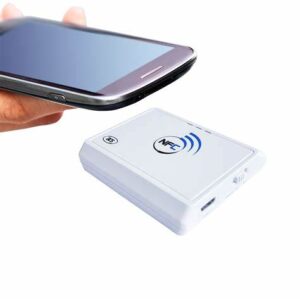Table of Contents
ToggleIntroduction
In today’s technologically advanced world, Bluetooth and Near Field Communication (NFC) are two popular wireless communication technologies frequently used in various applications. While both technologies facilitate wireless connections and data exchange, they differ significantly in terms of range, speed, power consumption, and intended use cases. Understanding the distinctions between Bluetooth and NFC can help users make informed decisions on which technology best suits their needs.

Range and Speed
Bluetooth Range and Speed
Bluetooth technology is designed for longer-range communication and can operate up to 100 meters, depending on the device and environment. It offers relatively high data transfer speeds, typically reaching up to 3 Mbps in Bluetooth 2.0+EDR (Enhanced Data Rate) and even higher in more recent versions, such as Bluetooth 5.0. This makes Bluetooth suitable for applications that require robust data transmission over a moderate distance, such as wireless headphones, speakers, and smart home devices.
- Key Points:
- Operates up to 100 meters.
- Data transfer speeds up to 3 Mbps or higher.
- Ideal for audio devices, smart home setups, and other applications requiring moderate-range connectivity.
NFC Range and Speed
In contrast, NFC technology is intended for very short-range communication, typically within a few centimeters. NFC’s data transfer speeds are significantly lower, usually around 424 kbps. The limited range and speed of NFC make it ideal for applications requiring quick, secure interactions, such as contactless payments, access control, and pairing devices.
- Key Points:
- Operates within a few centimeters.
- Data transfer speeds around 424 kbps.
- Ideal for contactless payments, secure access control, and device pairing.
Power Consumption
Bluetooth Power Consumption
One of Bluetooth technology’s strengths is its relatively low power consumption, especially with advancements like Bluetooth Low Energy (BLE). BLE is designed to extend battery life in devices by consuming significantly less power while maintaining efficient communication. This makes Bluetooth an excellent choice for battery-operated gadgets, such as fitness trackers, smartwatches, and certain IoT devices.
- Key Points:
- Bluetooth Low Energy (BLE) offers significantly reduced power consumption.
- Extends battery life in wearable and portable devices.
- Ideal for continuous or frequent communication needs in battery-powered gadgets.
NFC Power Consumption
NFC technology, while also designed to be power-efficient, operates differently than Bluetooth. Because of its short range and quick interaction requirements, NFC consumes very little power. It even includes a passive mode, where the NFC tag does not require its own power source and can draw energy from the NFC reader. This characteristic makes NFC suitable for applications like smart cards, keycards, and other small, passive devices.
- Key Points:
- Very low power consumption.
- Passive mode allows operation without a power source.
- Ideal for applications requiring quick interactions and minimal energy use.
Use Cases
Bluetooth Use Cases
Bluetooth technology’s longer range and higher data transfer speeds make it versatile for a broad range of applications. It is commonly used in wireless headsets, speakers, computer peripherals, and automotive systems. Additionally, Bluetooth’s ability to connect multiple devices simultaneously enhances its utility in various setups, such as smart homes and personal area networks (PANs).
- Key Points:
- Versatile for numerous applications.
- Commonly used in audio devices, peripherals, and automotive systems.
- Supports multiple device connections for smart home integration and PANs.
NFC Use Cases
NFC’s primary strength lies in its ability to facilitate secure, short-range communications swiftly. This makes it ideal for tap-and-go services like contactless payments (e.g., Apple Pay, Google Wallet), access control systems (e.g., office keycards), and quickly pairing devices (e.g., Bluetooth pairing via NFC tap). NFC is also used in marketing, such as smart posters and product tags, where users can tap their phones to access additional information.
- Key Points:
- Ideal for secure, short-range interactions.
- Widely used in contactless payments and access control.
- Facilitates quick device pairing and interactive marketing solutions.
Security
Bluetooth Security
Bluetooth technology offers multiple layers of security, including encryption and authentication protocols, to ensure secure data transmission. However, the extended range makes Bluetooth more susceptible to certain security threats, such as eavesdropping and unauthorized access. Regular updates and security measures are essential to maintain the integrity of Bluetooth communications.
- Key Points:
- Provides encryption and authentication protocols.
- Susceptible to security threats due to longer range.
- Regular updates and security practices enhance protection.
NFC Security
NFC’s very short range inherently provides a layer of security, as it requires devices to be in close proximity (usually within a few centimeters) to communicate. This limits the risk of eavesdropping and unauthorized interceptions. Additionally, NFC transactions often involve secure elements and encryption, further enhancing their security.
- Key Points:
- Short range reduces risk of unauthorized access.
- Secure elements and encryption enhance security.
- Ideal for secure transactions and data exchanges.
Conclusion
While both Bluetooth and NFC are valuable wireless communication technologies, they serve distinct purposes based on their capabilities and design. Bluetooth’s longer range and higher data transfer speeds make it suitable for continuous, moderate-range connections in devices like audio peripherals and smart home systems. Conversely, NFC’s short range and swift, secure interactions make it ideal for applications like contactless payments, access control, and quick device pairing. By understanding these differences, users can better leverage the strengths of each technology to meet their specific communication needs.
Deciding between Bluetooth and NFC depends on the specific requirements of the task at hand, whether it involves long-range, continuous connectivity, or secure, short-range transactions. Both technologies will continue to play crucial roles in the evolving landscape of wireless communication.
